Paint rollers have been used universally in painting and plastering for over 50 years. During this time, the instrument structurally remained practically unchanged. The paint roller is used to process smooth surfaces of a large area, which simplifies the work of the plasterer. Thanks to the possibility of choosing various fur coats, you can achieve all kinds of decorative effects on walls, floors and ceilings, change the texture of surfaces, use any paints or even decorative plasters.
- Types, design features and purpose
- Design
- Equipment and classification
- What else do you need to know about this tool?
- How to work with the tool?

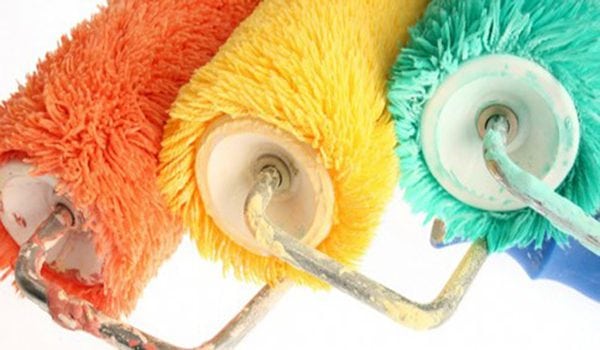
Types, design features and purpose
Rollers are used not only for applying paints, but also for adhesives, plasters, primers. They are intended for painters and are actively used by furniture makers to process workpieces or parts in industry. Many compare rollers with a conventional brush and try to find the advantages or disadvantages of the tool.
The professional does not have such questions, since tools with various nozzles and brushes of various types have their own purpose and narrow specialization.
Advantages over the brush:
- Even the middle roller in one pass covers a large area. It takes tens of times more time to brush the same surface with a brush.
- The clasp for the roller (handle) is created in such a way that the painter can quickly replace the fur coat on it and with one tool solve various problems and work with any type of finishing materials.
- It evenly distributes the paint on the surface, does not leave smears, visible stains, as is the case with a brush. Using a woolen or nylon hand roller, you evenly distribute the material on the surface. Using a brush, the material is simply smeared, without penetrating into the pores, cracks, and simply laid on the surface. The result is a completely flat, smooth and uniform surface.
- Efficiency when applying paint is much higher than when using any brushes. In addition, you can use extension cords and handles for working with ceilings, walls, floors, and finishing work on facades.
- A high-quality velor roller leaves no lint or traces of a fur coat, but the brush begins to crumble over time, and if the master did not notice the appearance of bristles on the work surface in time, correcting errors can lead to additional costs.
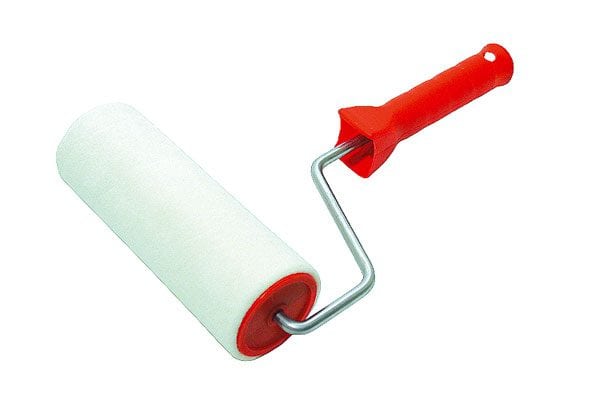
Disadvantages:
- Using a paint roller for painting corners and joints, you will need a tool of a special design, usually a narrow roller.
- The work is carried out using a tray for paint and its even distribution on the fur coat. In some cases this is inconvenient.
- The width of the roller does not allow its use in hard-to-reach places. To paint uneven surfaces is very problematic, you have to use a brush in any case.
Separately, it is worth mentioning that the fur coats for the roller help to create decorative effects of various kinds that cannot be realized with a brush. For example, a long-nap roller forms a textured surface, giving it extra depth.Even a simple passage of the tool on a dried surface creates the effect of an orange peel if you do not have a suitable decorative coat for the roller on hand. The relief pattern is enhanced by sources of light and shadow.
to contents ↑Design
The tool consists of a metal handle-retainer, a working surface (roller) and a fur coat. Sometimes rollers with protection are also used. Depending on the size, purpose, design features of the clasp, various types of tools are produced.
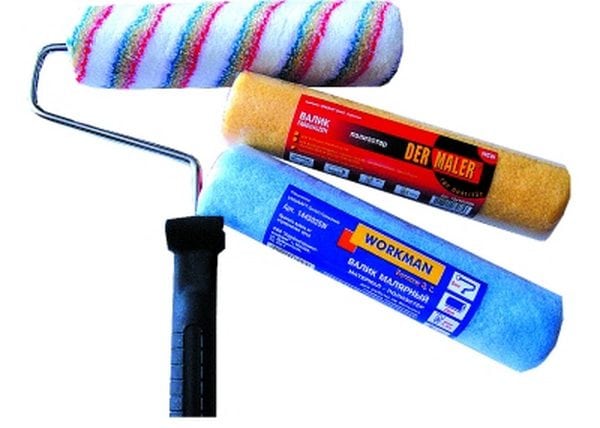
If you do not know how to choose a roller for painting, you should first of all proceed from the amount of future work. A tool with a large fur coat, long handle is ideal for surface treatment of walls, for work on the floor or ceiling. It is better to choose a mini for creating knurls, prints, stencils, for working with corners, applying liquid paints.
The handle of the tool is very important for comfortable and efficient work. It should not interfere with the use of the bath for the roller, should not slip, hang, interfere with the application of liquid compositions.
Most handles are designed so that you can use a stationary extension cord design. Before choosing a roller for painting, carefully inspect the plastic handles, the connector for the extension cord. It can have various types of clamps, which can be designed, including for factory extension cords, which will entail additional costs. It is convenient to handle with a handle:
- vinyl wallpapers;
- doors
- liquid wallpaper on the walls and ceiling;
- perform work on applying bitumen on the roof;
- oil paint wood floors.
In this case, the plasterer painter performs all the work from one place, covering a large area around him. With the nozzle, you can quickly paint technical rooms, roofs, high walls, and process ceilings.
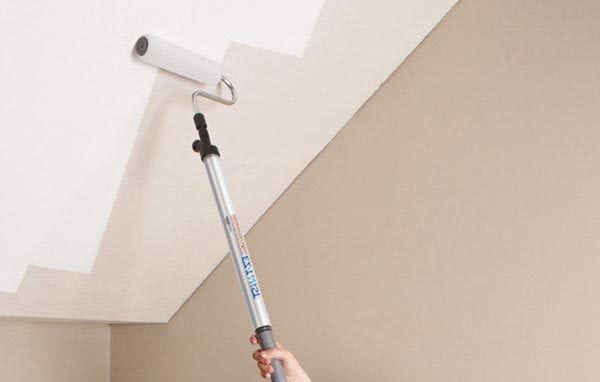
Equipment and classification
Thanks to a wide selection of fur coats, a conventional roller can be used on various processes with different efficiencies.
Depending on the size, the tool for applying materials is distinguished into the following types:
- Mini roller - applying paint, glue to small areas, working with corners, stencils.
- Midi - designed to work with alkyd, polyurethane, polyamide, polyacrylic paint. Most commonly used by painters. Convenient for door painting, floor, wall surface.
- Special rollers for work with structural paint, bituminous compositions, aggressive materials, on uneven surfaces.
The roller and the mini roller can also differ in the type of fur coat:
- Thread roller - creating a special texture on the surface by applying a repeating ornament. Thread roller is used with polyurethane, polyamide paints, for drawing a pattern on the finished coating.
- Perforated roller - has a similar purpose, like a hand tool with a thread coat. This is the application of structural coatings, decoration of walls, ceilings.
- Roller artificial fur - used to work with any water-dispersion paints. Faux fur has good characteristics that prevent the coat from intensive abrasion.
- Felt roller - a soft tool for various types of surfaces. It is used to work with water-based paints and paints containing aggressive solvents. High-quality felt can be effectively applied to work on a smooth and rough surface. This is important for technical rooms, when used on wood, ceilings and walls with untreated concrete.
- Nylon roller - used to work with water-dispersible, oil, paints, varnishes, solvent-containing formulations.
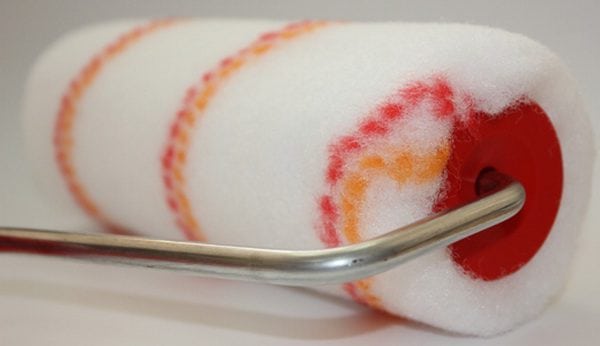
- Foam rubber is used for water-glue compositions, it is also used for varnishes, but it is strictly forbidden to use a tool with solvents that simply dissolve the foam nozzle. Spongy and fur nozzles are often used as elements for decorating surfaces after applying paint to create the effect of ivory, orange peel, microcracks.
- Enamel rollers - a special tool that is designed to expel air from under vinyl or any other wallpaper. Sometimes they are used for technical purposes, in production, when connecting several coatings on a glue basis, or in the distribution of thick compositions, including water-based.
- Mini roller for working with seams - has a solid rubberized base, designed to pass along the seams and improve adhesive properties.
- A special tool with a special design - needle, angle roller and others.
to contents ↑It is worth noting that all nozzles are applicable for all three tool sizes. That is why, using a mini roller velor or rope roller, you can achieve high quality processing in a small area.
What else do you need to know about this tool?
Professionals pay special attention to the type of attachment of the roller to the metal handle.
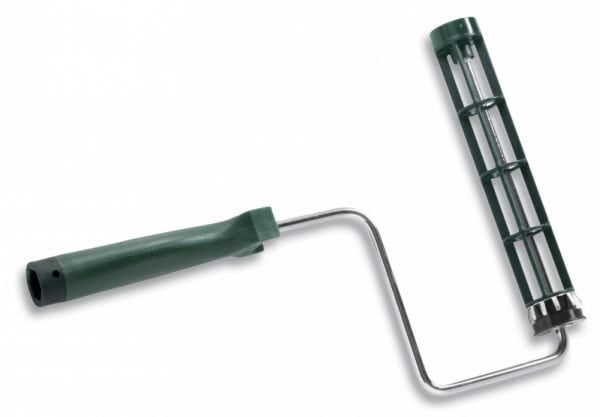
There is a tool with three types of systems:
- clasp;
- wireframe;
- special.
The clasp reliably fixes the roller, so that the mini-roller or midi becomes reusable. You can only change the fur or sponge head. The groove at the end of the metal clasp and the retainer provide quick removal of the roller, its replacement, giving other characteristics of the working surface.
The frame system has a special roller design, which is designed in such a way that there is a plastic bearing inside, plastic plugs and a lock. The fur or foam coat is fixed with a special mechanism with a rotational element and stops.
to contents ↑How to work with the tool?
To avoid the appearance of areas with marriage on the surfaces that you process, you need to follow some recommendations when working with this tool:
- Use only a clean mini roller, a container for glue, paint or varnish.
- Before applying the paint, it is worth checking the condition of the fur or foam coat - it should not leave spots, the pile should not remain on the surface.
- Pay attention to the metal elements, they should not be rust, the roller should rotate freely and evenly.
- Before starting work, immediately prepare all fur and foam coats, a mini-roller for working in hard-to-reach places, plastic film to prevent the spread of splashes, an extension cord (if you plan to work with high walls or ceilings).
- Using a paint container, evenly distribute the paint or glue over the surface of the roller. To do this, just swipe back and forth several times, the coat will absorb a sufficient amount of material.
- When working with textured tools, it is important to follow the technology, since the surface characteristics will be different, depending on the degree of drying. Even using the best quality fur coats you will not receive a guarantee of achieving a result. It is important to work under certain conditions, closely monitor the drying time of paint, varnish, structural paints, liquid wallpaper, bitumen.
Regardless of the type of tool, its design, it will take a little time to hone the skills of painting and plastering. With proper use, the work will be efficient, quick and easy.



